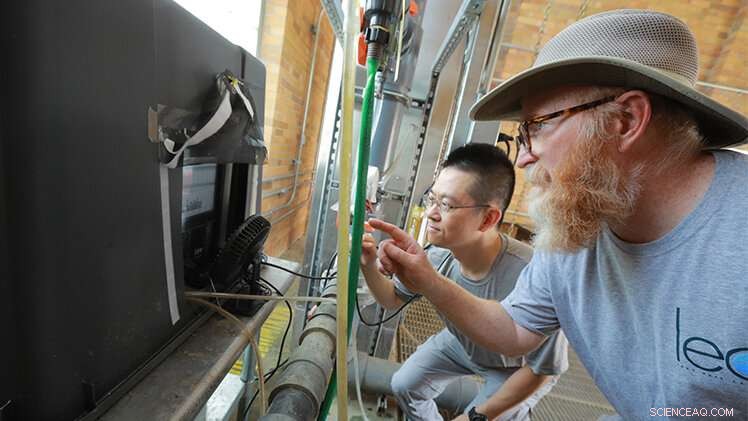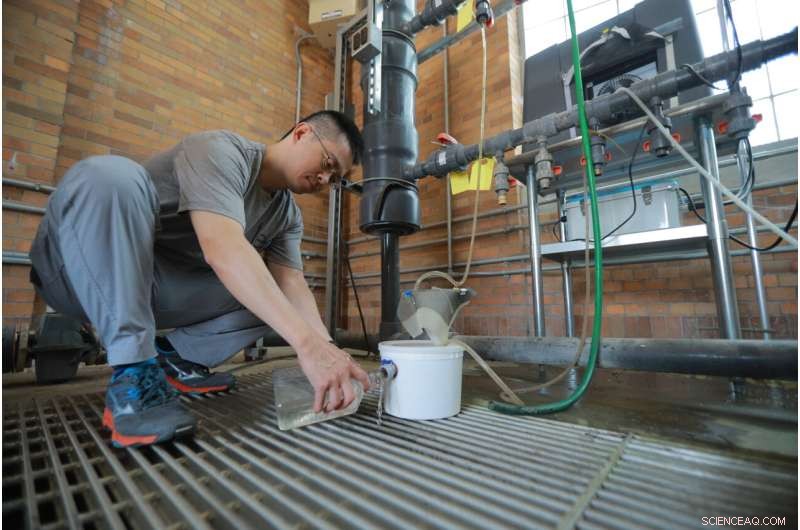
Il dottor Thomas Bridgeman, professore di ecologia e direttore dell'UToledo Lake Erie Center, a destra, e il dottor Kuo-Pei Tsai, un ricercatore post-dottorato, leggono i dati provenienti dal sistema di monitoraggio delle alghe online in fase di test nell'acqua grezza della città stazione di pompaggio per proteggere la fornitura pubblica di acqua potabile durante la stagione dannosa della fioritura delle alghe. Credito:Daniel Miller, Università di Toledo
Mentre il pericolo incombe negli specchi d'acqua in tutto il mondo dove fioriscono alghe tossiche, una piccola vasca di plastica a Toledo sigillata per proteggere da schizzi, ragni e feci di uccelli potrebbe contenere una tecnologia rivoluzionaria nella lotta contro il crescente problema ambientale.
Gli scienziati delle alghe dell'Università di Toledo stanno testando un sensore ottico in tempo reale presso l'impianto di trattamento delle acque di Toledo nell'ambito del monitoraggio dell'acqua di sorgente per proteggere l'approvvigionamento pubblico di acqua potabile durante la stagione dannosa della fioritura delle alghe.
Ogni 15 minuti il dispositivo beve un sorso dell'acqua del Lago Erie che entra nell'impianto, legge il campione e mette online i dati di misurazione per consentire a ricercatori e gestori di servizi idrici di accedervi da remoto.
Il suo più grande valore è la capacità di dire se i minuscoli organismi unicellulari noti come cianobatteri che compongono le dannose fioriture algali nel lago Erie sono fragili e iniziano a rompersi. Se le cellule si rompono, rilasciano la tossina. La tossina disciolta è più difficile da rimuovere per gli impianti di trattamento dell'acqua perché può passare attraverso i filtri e deve essere rimossa con mezzi chimici prima che l'acqua lasci l'impianto per i nostri rubinetti.
Da luglio, gli scienziati di UToledo hanno controllato i cavi e i tubi del dispositivo per assicurarsi che funzioni correttamente. Stanno anche facendo esperimenti di laboratorio presso l'UToledo Lake Erie Center che stanno dimostrando che la tecnologia funziona nel modo previsto.
"Il nostro lavoro di quest'estate con il dispositivo PhycoSens è il primo test di questo sistema di monitoraggio delle alghe online in un impianto di acqua potabile negli Stati Uniti", ha affermato il dottor Thomas Bridgeman, professore di ecologia e direttore dell'UToledo Lake Erie Center. "Se mostriamo successo all'impianto di trattamento delle acque di Toledo e in tutta la regione per rilevare e notificare immediatamente il rilascio di tossine, allora può essere ampliato a livello nazionale. Finora sta mostrando grandi promesse".
L'implementazione di prova del sistema di sensori di monitoraggio avanzato fa parte di un progetto UToledo da 1,4 milioni di dollari finanziato dal Corpo degli ingegneri dell'esercito degli Stati Uniti, iniziato più di un anno fa e incentrato sul rilevamento precoce e sulla gestione delle proliferazioni algali dannose.
Da quando la crisi idrica di Toledo del 2014 ha lasciato mezzo milione di residenti senza acqua di rubinetto sicura per tre giorni, i ricercatori hanno maggiore chiarezza sul fatto che non sono solo le dimensioni e l'aspetto della fioritura algale che contano, ma ciò che sta accadendo nelle cellule.
I dispositivi Bridgeman realizzati dall'azienda tedesca bbe Moldaenke utilizzano sensori ottici per misurare in tempo reale quante e quali alghe stanno entrando nell'impianto di trattamento delle acque, compresi i cianobatteri. Ancora più importante, i sensori possono fornire un avviso delle cellule dei cianobatteri che si aprono e perdono il loro contenuto, comprese le tossine che possono contenere, nell'acqua.
"A large release of toxin can happen in a matter of hours, and it is critical for water plant operators to have this information so they can adjust their treatment levels quickly, before dissolved toxin can get through the plant," Bridgeman said. "The data are produced every few minutes, which makes it a useful early warning tool for a potentially rapidly changing algal situation."
Notable for researchers is data collected in late July showing the peak of the bloom and its decline.
"So far we have not detected any of that cell breakage at the water treatment plant or near the water intake out in the lake using the automated sensor, which is good news," Bridgeman said. "However, UToledo crews on our research vessel taking water samples out in the lake throughout Lake Erie's western basin—not near the water intake—have detected cell breakage using the manual version of the same device this season."
Bridgeman said that cell breakage events leading to large releases of dissolved toxin don't happen every year in Lake Erie.

Dr. Kuo-Pei Tsai, a post-doctoral research associate at the UToledo Lake Erie Center, works at the city's raw water pump station with the plastic storage tub containing a game-changing technology in the fight against toxic algae. Credit:Daniel Miller, The University of Toledo
"It happened in 2019 and possibly in 2014 but not to a large extent this summer, at least not near the water treatment plant's water intake out in the lake," Bridgeman said.
The Toledo Water Treatment Plant's laboratory makes the most use of the data.
"The experimental optical sensors being tested at the raw water pump station are a useful source for both the changes and the severity of algae levels coming from the lake," said Jeff Martin, chief chemist at the Toledo Water Treatment Plant. "We didn't have remote access to the data until part of the way through the bloom season due to computer issues, but since then it has been a welcome tool in treatment decisions."
Bridgeman has studied harmful algal blooms for two decades. His laboratory is one of the key locations for tracking and providing early warning of harmful algal blooms in the western basin of Lake Erie.
He said while the new instruments can detect the health, or physiological condition, of the cyanobacteria, they do not provide actual toxin readings, making them a supplemental weapon in a water utility manager's arsenal to efficiently and economically adjust treatment to maintain drinking water safety.
"Measuring toxin still requires a separate, fairly time-consuming test," Bridgeman said. "Therefore, the fast optical measurements will be coordinated with slower chemical toxin measurements to provide a complete picture of what is happening in the lake water that is entering the water plant."
The device will be removed from the water treatment plant for analysis in October and then his team will study the results and potentially put it back in the plant next summer.
Bridgeman's device monitoring tests are one part of a larger, wide-ranging project funded by the U.S. Army Corps of Engineers that also includes faculty in the UToledo College of Engineering.
Dr. Youngwoo Seo, professor of civil and environmental engineering and chemical engineering, leads the three-year project to improve water quality from the source to the tap.
Some of the technology and techniques being tested by UToledo are new to water treatment plants in the western hemisphere.
The project features two different parts working together:
Dr. Dae-Wook Kang, assistant professor of civil and environmental engineering, leads a molecular approach to develop a robust detection method, and his analysis will help better understand what triggers the toxin gene production of cyanobacteria.
Seo is focused on mitigation and the treatment method for toxin removal. His laboratory is working on the biological degradation of cyanobacteria and their toxins using the naturally occurring bacteria and viruses from the lake and NSF-approved chemical treatments. + Esplora ulteriormente